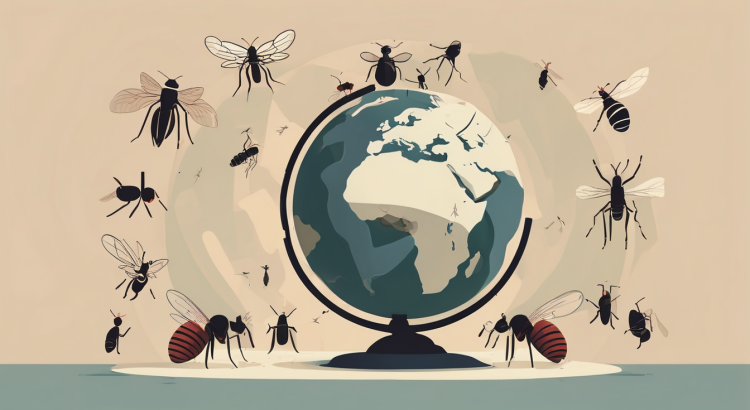Top Tens Things lists the most dangerous insects on that pose serious health risks and demand real attention worldwide.
Why the Most Dangerous Insects on Earth Matter
The most dangerous insects on are not always the biggest or most frightening to look at. Many appear harmless but can transmit deadly diseases or trigger severe allergic reactions.
These insects have evolved efficient ways to bite, sting, or spread pathogens. As a result, they silently affect millions of people each year.
Understanding where they live, how they attack, and how to avoid them helps reduce risk. In addition, clear information supports better public health action.
Mosquitoes: Tiny Killers With Huge Impact
Mosquitoes often top any list of the most dangerous insects on Earth. They do not kill directly through their bite. However, they act as carriers for deadly diseases like malaria, dengue, Zika, yellow fever, and West Nile virus.
Female mosquitoes need blood to develop their eggs. During feeding, they can inject parasites or viruses into the human bloodstream. As a result, millions fall ill every year.
Simple prevention steps help a lot. Use mosquito repellent, install window screens, and remove standing water around homes.
Tsetse Flies: Silent Spreaders of Sleeping Sickness
Tsetse flies live mainly in sub-Saharan Africa and are counted among the most dangerous insects on that continent. Their bites can transmit parasites causing African trypanosomiasis, also called sleeping sickness.
The disease starts with fever and headaches. After that, it can attack the nervous system and become fatal if untreated. Rural communities living near riverine forests face the highest risk.
Control strategies focus on trapping flies, clearing vegetation, and treating infected people. These efforts have reduced cases but the threat remains.
Assassin Bugs and Chagas Disease
Assassin bugs, also known as kissing bugs, earn a place among the most dangerous insects on the American continent. Some species carry the parasite Trypanosoma cruzi, which causes Chagas disease.
They usually bite around the mouth or eyes at night. Their infected feces can enter the body through broken skin or mucous membranes. Over time, Chagas can damage the heart and digestive system.
Improving housing, sealing cracks in walls, and using bed nets can reduce bites. Meanwhile, early diagnosis is critical for effective treatment.
Fleas: Tiny Vectors With a Dark History
Fleas are small jumping insects that once helped spread bubonic plague. Their role in pandemics makes them part of the most dangerous insects on record.
They feed on the blood of animals and humans. When infected with plague bacteria, they can pass it to new hosts. Today, plague is rare but still appears in some regions.
Pet care and basic hygiene limit flea populations. Regular cleaning and proper treatment for cats and dogs are essential steps.
Sandflies and the Burden of Leishmaniasis
Sandflies are another group within the most dangerous insects on the planet due to leishmaniasis. Their bites can transmit parasites that attack skin, mucous membranes, or internal organs.
Cutaneous leishmaniasis causes skin ulcers. Visceral leishmaniasis can be deadly if not treated. Poor housing, malnutrition, and environmental changes often increase risk.
Preventive actions include insecticide-treated nets, protective clothing, and better waste management. Public awareness also plays a vital role.
Houseflies: Filthy but Often Ignored
Common houseflies are often overlooked in lists of the most dangerous insects on Earth. Yet they can carry many pathogens on their legs and body hairs.
They breed on garbage, feces, and rotting food. After that, they land on meals and kitchen surfaces, spreading bacteria and parasites that cause diarrhea, typhoid, and other illnesses.
Good sanitation, covered food, and proper waste disposal sharply reduce the danger from houseflies.
Bees, Wasps, and Hornets: Stings That Can Kill
Bees, wasps, and hornets are vital pollinators and predators of pests. However, they still belong to the most dangerous insects on lists due to their stings.
Most people feel pain and swelling only. Nevertheless, some suffer severe allergic reactions called anaphylaxis, which can be life-threatening without rapid treatment.
Staying calm around nests, avoiding strong perfumes outdoors, and using protective clothing help prevent stings. People with known allergies should carry emergency medication.
Driver Ants and Army Ants
Driver ants and army ants move in massive swarms, placing them among the most dangerous insects on the ground. They can overwhelm and consume small animals quickly.
Humans rarely die from their bites, but large colonies can cause serious injuries, especially to vulnerable people. Their powerful jaws make them hard to remove once they latch on.
Communities usually avoid their paths and close doors and windows when swarms move through an area.
Fire Ants and Painful Invasions
Fire ants deliver venomous stings that burn and itch intensely. Their aggressive behavior keeps them in discussions about the most dangerous insects on invaded lands.
They form large colonies and may attack in groups. Multiple stings can trigger allergic reactions or secondary infections.
Controlling fire ants often requires baiting, careful pesticide use, and monitoring of disturbed soil where they like to nest.
Bullet Ants and Extreme Pain
Bullet ants are famous for one of the most painful stings known. This alone pushes them into the most dangerous insects on pain scales.
The sting causes intense, throbbing pain that can last for hours. While deaths are rare, the experience is so severe that some indigenous rites use it as a test of endurance.
Staying alert in tropical forests and avoiding contact with tree trunks or branches where they nest helps reduce encounters.
Staying Safe Around the Most Dangerous Insects on Earth
The most dangerous insects on Earth shape human health, agriculture, and daily life. They spread disease, cause injuries, and sometimes alter entire communities.
Simple habits provide strong protection. Use repellents, wear long sleeves, keep living spaces clean, and manage standing water and waste carefully.
Read More: Global strategies to reduce insect-borne infectious disease risks
Public education, research, and cooperative control programs can lower the impact of these species. Therefore, informed citizens help reduce threats facing their families and neighbors.
By understanding how the most dangerous insects on operate and where they thrive, people can travel, work, and live with greater confidence and safety.



